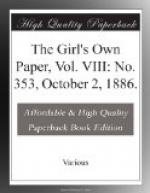The work known as Leek embroidery recommends itself in many ways, it being very reasonable in price, easily executed, and extremely rich and handsome when finished. The foundation is Tussore silk, specially made with the pattern to be embroidered upon it printed upon the foundation, during its manufacture, and therefore indelible. The colouring of the foundation is either cream, straw, pink, blue, green, or terra-cotta, and the pattern is not printed in outline only, but filled up with indications guiding the arrangement for the centres of flowers, veins of leaves, and other distinguishing marks. To work the embroidery it is necessary to line the Tussore with fine unbleached muslin, and to work with Tussore silk and Japanese gold thread. The Tussore silk costs 1d. the skein, and is dyed in every shade of Oriental colouring. Three to four shades of a colour are used to work in a flower, and two shades of green for the leaves. The stitch is crewel-stitch worked very close. No shading about each leaf is necessary, but different greens are used for different leaves, and thus a variety of colouring is attained without trouble. Every part of the pattern, the bordering included, is worked, and only the foundation left, showing where it forms the background to the design. The gold thread is laid on as the finishing touch. It is placed round all the chief parts of the design, and sewn on as an edging with a couching stitch; that is to say, the gold thread is held tightly stretched in its position with the left hand, while a stitch brought from the back of the material is passed over it and put down to the back again with the right hand. Lines of gold are used to mark out the border pattern, and are fastened down with the couching stitch. When sewing on the gold it is very important to keep it tightly stretched, as if put on loosely it is not effective. If the work is at all puckered, iron it with a warm but not hot iron on the wrong side before laying down the gold thread. Leek embroidery is sold by the yard in strips, varying from one inch to twelve inches in width, and costing from 6d. to 2s. the yard. These strips are used for mantelpiece borders, table borders, chair backs, and curtain bands, according to their width. They look best mounted upon plush or velveteen, but are often mounted upon Liberty’s Oriental silks, or made up as perfectly plain bands. When used for chair backs or for hanging firescreens the background should be handsome, and either ruby or dark blue in colour, and the work arranged either straight down its centre or crossing it in a number of diagonal lines. This manner of making up is newer and more effective than merely laying it on as an edging. Bands of unmounted Leek embroidery, simply lined with twill, are much used for looping up summer curtains, and give richness to the soft, creamy materials now employed for curtains.
As dress trimmings Leek embroidery is good, the wide bands making a waistcoat front and the narrow the cuff trimmings. To a velveteen winter dress a waistcoat and cuffs so made are an admirable finish as long as the embroidery is kept subdued by rich colours, and the gold carefully put on, while for dinner dresses a broad panel of embroidery is carried down the skirt, and the waistcoat cut low, and no trimming required for the sleeves.




